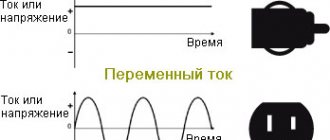Recently, heating systems based on electric convectors have become widespread for heating houses, especially where there is no possibility of connecting mains gas or such connection is very expensive. Compared to heating using the “boiler - water radiators” scheme, heating with electric convectors has undeniable advantages. It is environmentally friendly, it does not require premises for a boiler room or fuel storage, it is easy to install, has low inertia, is reliable and predictable, does not require maintenance, and is much cheaper in terms of equipment and installation costs. The widespread use of heating with electric convectors is hampered by stereotypes that convectors are exclusively auxiliary heaters in addition to the main heating, that they are suitable only for small houses with an area of 80-100 sq.m., that they have the highest energy consumption compared to other types of electric heating, in in particular, compared to heating with an electric boiler.
The electric convector is no longer an auxiliary heater Source home-comfort.ru
Unlike inexpensive convectors with a minimal set of functions, modern convectors are practically different heating devices, the task of which is not just to heat, but to heat wisely. Therefore, on their basis it is possible to install a full-fledged heating system.
Let’s define the terminology of what is considered a full-fledged permanent heating system, and what is simply heating. A complete heating system is:
- possibility of autonomous safe operation for a long time without human presence;
- ease of management, both individual elements of the system and the entire system as a single device, including remotely;
- energy efficiency is a set of devices and technologies that optimize the operation of the heating system to reduce energy consumption while maintaining comfort.
Let's consider the options for using electric convectors and evaluate them according to these criteria.
Heating by convectors with mechanical thermostats
The simplest heating, often used in summer cottages, is inexpensive convectors with a mechanical thermostat. The main capabilities of such convectors are adjusting the temperature with a knob or slider, choosing the operating power - full or half of the nominal value.
This type of convector is suitable for short-term or additional heating to the main heating and cannot be considered as full-fledged for year-round use. Such electric heaters do not use energy-saving technologies, their task is simply to heat, it is risky to leave them unattended (if the heater is an open filament), they operate with large errors of several degrees, each convector must be adjusted separately, and there is no possibility of control via the Internet. The use of GSM or WiFi sockets does not fundamentally change anything, except for the ability to remotely turn on and off an electrical appliance. Installing a room mechanical thermostat that controls several convectors will allow you to set the temperature from one device, but this is the only advantage of such a connection of convectors.
Scheme with a mechanical room thermostat Source home-comfort.ru
The main advantages of gas convectors for wooden houses
All the complex nuances that needed to be understood before choosing this equipment have been sorted out, all that remains is to list the advantages of gas convectors for wooden houses:
- Economical - if a wooden house is assembled in accordance with the rules and does not have shrinkage cracks, then a very small amount of gas will be required for its heating;
- The smallest boiler allows you to heat a room with a total area of up to 350 m3, which is the size of a huge house, but subject to ceilings of 2.5 meters;
- There are double-circuit boilers that will supply your wooden house not only with heat, but also with hot water; their price is slightly higher, but the advantages are obvious;
- To supply heat to the convector, you can use either automatic or manual ignition;
- Provided that ventilation standards are met, the natural outflow of gas occurs without difficulty, and there is no danger of their accumulation.
Heating by convectors with electronic thermostat
If there are several convectors and they are used for a long time, then simply heating is no longer enough. The first step towards energy efficiency is the ability to program temperature settings for weekdays, weekends, nights and daytime hours so that we can work economically when and where we need it in our weekly schedule. To do this, we will replace mechanical thermostats with electronic ones. An electronic thermostat is a thermostat, but with more precise adjustment of the on/off temperature, plus “brains” that allow you to configure the weekly cycle schedule and the main operating modes (comfortable, economical, minimal). Therefore, it is more correct to call an electronic thermostat a control unit.
General requirements
Please note that in front, at a distance of half a meter, it is also undesirable to place any objects - cabinets, bedside tables, sliding tables, armchairs and much more. The diagram for connecting the convector to the electrical network is as simple as three kopecks
In most cases, equipment is connected to the network via a wire with a plug. Therefore, next to each electrical appliance you need to install sockets - we mount them side by side on the wall and connect them to the house network. They should be located neither below nor above, but on the side, where they will not overheat from the radiated heat. The optimal installation distance is at least 20-30 cm from the place where the convector is mounted on the wall
The diagram for connecting the convector to the electrical network is as simple as three kopecks. In most cases, equipment is connected to the network via a wire with a plug. Therefore, next to each electrical appliance you need to install sockets - we mount them side by side on the wall and connect them to the house network. They should be located neither below nor above, but on the side, where they will not overheat from the radiated heat. The optimal installation distance is at least 20-30 cm from the place where the convector is mounted on the wall.
Heating with convectors controlled via the Internet
We will continue to modernize the system. If the house is not permanently inhabited, then there is a need for remote monitoring and control of convectors via a mobile application. The mobile application is actually an extended heating system control console. In it you can add/remove heating devices, create separate zones, assign convectors to these zones, managing the zone as a separate device, set parameters for temperature conditions and the operating schedule of each device or zone. As a rule, a mobile application, in addition to controlling convectors, has the ability to control other climate control and household appliances - water heaters, ventilation, air conditioning, lighting, etc., becoming the control center of a smart home.
For such intelligent control, convectors must be connected to the Internet.
There are two most common solutions:
1. System based on inverter convectors. Each convector is equipped with an inverter control unit marked digital Inverter. Electrolux convectors of the Transformer System series with replaceable control units are suitable for this. The inverter control unit has all the same functions as the electronic unit, plus two key differences: the presence of a USB connector for installing a WiFi module for wireless communication with a WiFi router and a fundamentally different operating algorithm of the heating element - with automatic change of heating power.
Advantages and disadvantages of floor-mounted convectors
We list the positive and negative features of in-floor heaters without dividing them by the type of energy carrier used and listing the characteristics inherent in all convectors as a whole.
- due to the location of the unit, the lower, coldest layers of air are heated;
- installation of devices does not reduce the usable volume of the room;
- quick access to working mode;
- preventing the formation of condensation on glazing.
- with high ceilings, building natural convection units into the floor is not effective - convective flows of heated air are concentrated high under the ceiling and cool down before they fill the actual volume of the room;
- convection from the level of the floor covering initiates intense movement of dust in the air, which is constantly present in the air during heater operation;
- inconvenience of daily care of niches in which household waste accumulates.
Video description
Connecting a convector using a wifi module to the Hommyn mobile application:
Heating system on convectors with inverter control Source home-comfort.ru
2. Convector system with electronic thermostats and central controller. The operation of the convectors is controlled by a controller connected by a cable to a wifi router or GSM module. The convectors are connected to the controller either by wire or by radio signal (in this case, an individual device code is used). Convectors are controlled through a mobile application and through a controller.
Diagram of a heating system with a controller Source home-comfort.ru
The first scheme does not require the purchase of an expensive controller and is more convenient, since you just need to install a small WiFi module in the USB connector and register the device in the mobile application.
The second option is more expensive and more complicated, since you need to purchase not only special thermostats, but also a controller, which must be powered from a 220V network and connected with a LAN cable to a WiFi router, which is not always convenient and aesthetically pleasing when the controller is placed on the wall.
Besides these important differences, there is another key difference. A convector with a mechanical or electronic thermostat from any manufacturer operates in two states: either turned on at rated power or completely turned off. In an inverter convector, the heating power is regulated differently. It changes automatically depending on the difference between the set temperature and the current one, as well as the rate of change of this difference. This principle of proportional-integral control is often used in industrial systems and, when used in household equipment, allows achieving high energy efficiency compared to classic on/off heater power control.
The thing is that any heating device operating on the on/off principle always has a switch-on temperature and a switch-off temperature that differ from the set one. If the convector thermostat is very sensitive, then its on and off cycles will occur with high frequency, that is, in fact, the convector will constantly work, consuming energy, and in addition constantly load the network when turned on. That is why, in order to reduce the frequency of switching on, thermostats are set with a backlash of several degrees. The downside of this is the excessive work of the convector. Let us explain with an example: the temperature in the convector thermostat was set to 23 degrees. The minimum hysteresis (temperature range for turning on and off) is 2 degrees. The thermostat will turn off the convector at a temperature of 24 degrees, and turn it on at a temperature of 22 degrees. Trifle? If this is one convector that is used for several days, yes, it’s a small thing. And if there are 8-10 such convectors and they operate for 7 months of the heating season, then a large amount of electricity is consumed, because every extra degree of overheating is a plus of 5-10% to the heat consumption. And it doesn’t matter whether the convector is controlled by an external room thermostat connected to the controller or weather automation or the convector’s own thermostat. In online stores, the characteristics of a convector often indicate an electronic thermostat with an accuracy of 0.5°C. The nuance is that you can very accurately set the temperature on the electronic thermostat of the convector using buttons (in mechanical convectors this is done by eye), but this does not mean that the convector will accurately maintain the temperature at the set value. If the convector is controlled according to the on/off principle, it will work with a temperature saw around the set value. And the higher the thermostat hysteresis, the higher the excess electricity consumption over a long distance.
Autonomous heaters
What to do if there is no central heating or gas in the garage, and the frequency of your visits to the premises does not allow organizing a scheme with a solid fuel boiler?
In this case, it would be quite logical to use electricity for heating.
Oil radiator
The simplest homemade oil radiator is a welded register already familiar to us with several modifications.
- There are no welds for connecting to the connections.
- The register, as a rule, is made portable, which implies the presence of legs.
- Jumpers between sections are present on both sides. Their diameter is made slightly larger than when assembling a register for water heating. The instruction is due to the fact that natural convection implies a minimum hydraulic pressure, and if so, the hydraulic resistance should also be minimal.
- A heating element or several parallel connected heating elements are installed at the end of the lower section.
- Oil acts as a coolant. Ideally, a transformer one, but even testing will do.
- The register is equipped with a small open expansion tank. As an option, the oil is not added a little to the top of the register, and the weld on its upper section is equipped with an automatic air vent.
Heater from a car radiator
Another interesting solution is a homemade garage heater made from a radiator.
The diagram is indicated by numbers:
- Radiator.
- Expansion tank.
- Forced air fan.
- A casing that protects the fan blades.
- Water pump.
- Oil supply pipe.
- Actuator.
- Fan drive belt.
- Electric motor.
- Frame stand.
- Drain tap.
- Block of heating elements.
- Blinds for adjusting the direction of air flow.
- Partially clogged radiator tubes are not a problem. They will miss the oil.
- Optimal motor characteristics are 300 - 500 watts at 1500 rpm.
- To heat the oil, heating elements with a total power of up to 3 kW are used. It is better to provide stepwise power adjustment by switching them on separately.
- Due to the small diameter of the radiator tubes, it is not worth using mining in this design. Transformer oil or antifreeze A-40 is suitable.
- The heater will operate most efficiently at an oil temperature of about 80C. The temperature is regulated by selecting the power of heating elements and fan speed.
Video description
To find out which is more economical - an inverter heating system or heating using an electric boiler and radiators, see the following video:
Stereotype: Only for small houses
And in conclusion, regarding the prevailing opinion that convectors are only for houses with a small area with the number of heating points no more than 6. The objective disadvantages of a heating system with an electric boiler are characteristic of both small houses of 80-100 sq.m., and houses of a larger area. This means that the disadvantages of one system and the advantages of another are scaled to houses with a larger area of 200-300 sq.m.
Advantages and scope of application
Before praising floor heating convectors - water and electric, let us highlight the main drawback of these devices - the lack of infrared heating. What happens: the air in the room warms up quickly, but objects remain cold. Only after a few hours the surfaces will reach air temperature and people will feel comfortable in the room.
The remaining disadvantages of convectors are insignificant or far-fetched. For example, stories about drafts being created (is convection so intense?) or increased dustiness. Our opinion on the disadvantages: not all users will like the appearance of convection floor heaters. But this is a matter of taste.
Now about the real advantages of convectors:
- convection - slow air circulation - promotes uniform heating of the room;
- the device quickly enters the heating mode; at a water supply temperature of 45...50 °C, a warm air stream is felt above the grate;
- the convection radiator casing does not heat up and does not pose a risk of burns to children;
- the heater can be easily adjusted manually or automatically using a valve + thermal head assembly (in electric versions - a thermostat);
- relatively small size and weight;
- the homeowner can order the desired body color from the standard RAL line (applies to water heaters).
Convection radiators can be safely hidden behind the screen, the heat transfer of the device will decrease slightly
Addition. If you don’t like the design of a wall-mounted convector, but are happy with the price, you can hide the device behind plasterboard sheathing or a screen. Heat transfer will decrease by 10% - the same amount of infrared radiation that will block the drywall. But it is necessary to install a convection grille for air passage, as shown in the photo.
Where can convectors be used:
- for general heating of country houses and apartments;
- on closed terraces of cottages, in office premises with stained glass windows instead of an outer wall;
- in kindergartens and other preschool institutions;
- in industrial premises with ceilings up to 3 m.
Maintenance of a convective device comes down to cleaning the heat exchange plates, between which dust accumulates. The operation is performed as soon as the heater becomes dirty.
Several general recommendations for connecting electric convectors.
Installing a heating system on electric convectors does not require any special skills, even if you are not an electrician. General recommendations must be followed:
- Do not place a total load of more than 3 kW on one line (3 convectors of 1 kW each, or 2 of 1.5 kW each)
- Connect such a line through a differential circuit breaker of at least 15A
- When connecting in series to one load line more than 3 kW, use a contactor
- When using a room thermostat or a GSM socket not manufactured by the convectors, pay attention to the permissible current for it
How to install an electric convector on a wall surface
Installation process instructions
So, if, for example, you wanted to install an electric convector on the surface of the wall, you need to proceed like this:
- Unpack the radiator design and turn it over to the reverse side.
- Remove the mount.
- Place the removed spider fastener against the wall in a suitable location (where installation will be performed) and mark the holes for the fasteners with a marker.
- If the wall is made of wood, screw the mount using wood screws (length 40-45 mm). If the wall is concrete, drill holes in advance with a hammer drill, then drive in dowels and install the frame, as in the photo below.
- Place the electric convector on the installed spider fastener.
- Connect the plug to the outlet, turn on the power.
- Set the appropriate temperature on the thermostat.
As you can see, installing an electric convector on a wall surface is absolutely nothing complicated, let alone connecting it. But there are several invisible points that should be taken into account during installation, which we discuss below.
Troubleshooting
As you can see, there is nothing complicated in the design of a gas convector. Due to its simplicity, this equipment serves for a long time and with high quality. But sometimes it happens that incomprehensible interruptions arise in its work. If you notice that the flame burns unevenly or is difficult to ignite at all, the problem is often a clogged nozzle.
Simply put, the hole through which the gas escapes becomes clogged with soot or other contaminants. In this case, you can easily clean it yourself. All you need for this is a thin needle. Use it to carefully clean the hole.
Very important: before starting work, be sure to shut off the supply of blue fuel to the equipment. For this purpose, a special tap is provided on the supply pipe.
It is absolutely forbidden to work with the device when gas enters it!
It is absolutely forbidden to work with the device when gas enters it!
If after cleaning the problem does not disappear, then the most reasonable option for further action would be to call a specialist from a specialized organization. Remember that gas equipment has a high fire hazard. All more or less serious work with it should be carried out only by craftsmen who have the appropriate license.
If you decide to repair the gas convector yourself, but do something wrong, this is fraught not only with subsequent fines from the gas service, but also with the possibility of a fire. You should not take such responsibility upon yourself; be sure to invite specialists to troubleshoot serious problems. Good luck and a warm home!
What is convection?
The phenomenon of convection was taught at school as part of the physics curriculum. This is the transfer of energy by jets of liquid or gas. As you know, warm air always rises and cold air sinks. Another striking example is water that is heated in a kettle. When the cookware sits on a lit burner, the warmer liquid rises from the bottom, which ensures uniform heating overall. This process is called natural convection. Convection can also be forced. This is the work of a fan, pumps, etc., under the influence of which the transfer of liquids and gases occurs.
Work specifics
Today, heat exchangers of various types are produced. In general, the features of their operation, as well as the design characteristics, are similar. The structural properties of such an element:
- Full body available.
- Presence of outlet and outlet pipes.
- Braking mechanism for combustion products. Its role is played by valves with cutouts that are installed on the axles.
The flaps can be turned. A zigzag chimney of varying lengths is formed. The valves can be adjusted to ensure the ratio of draft and heat transfer is as efficient as possible. Safety standards are met.
In this video you will learn how to make a heat exchanger:











